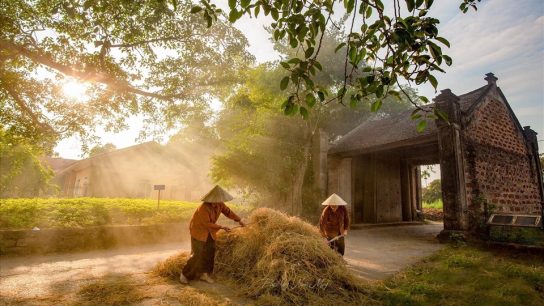Laos’ delectable cuisine is famous for its memorable flavors and rustic ingredients. Cuisine in the “Land of a Million Elephants” is basic but historically rich, and it will be served to visitors. A one-of-a-kind culinary experience with solid cultural roots exists in Laotian cuisine, which features an ideal combination of fragrant herbs, spices, and fresh fruit. When you are in Laos, make sure to try these ten dishes and drinks to experience the authentic flavors of this beautiful country.
1. Laap (Larb)

Laap, also known as Larb, is widely regarded as the national dish of Laos. This traditional meat salad combines minced meat – often chicken, beef, duck, fish, or pork – with fish sauce, lime juice, toasted rice powder, herbs, and spices. A delightful mix of green onions, cilantro, and fresh mint gives Laap its distinctive and refreshing taste. Typically enjoyed at home or during special celebrations, Laap symbolizes prosperity and good luck. It is commonly served with sticky rice to complete the meal.
Laap is especially popular in the northern portion of Laos and can be eaten raw or cooked. The Lao version of the meal is typically less sweet and more herbaceous than its Thai counterpart. Eating Laap with your hands is the best way to enjoy it thoroughly; use sticky rice to scoop up each bite. This customary eating style emphasizes family and community in Lao culture and improves the communal dining experience.
2. Tam Mak Hoong (Green Papaya Salad)
Green papaya salad, or tam Mak hoong, is a mainstay of Lao cooking and is renowned for its tart and spicy taste. This salad is made with shredded unripe papaya combined with sugar, fish sauce, lime juice, garlic, and chiles. Tomatoes, peanuts, and occasionally dried shrimp are used as garnishes. The harmonious blend of tart, piquant, caramel, and briny tastes makes this a cool dish ideal for Laos’s sweltering weather. It’s typically consumed as a light dinner or as a side dish.
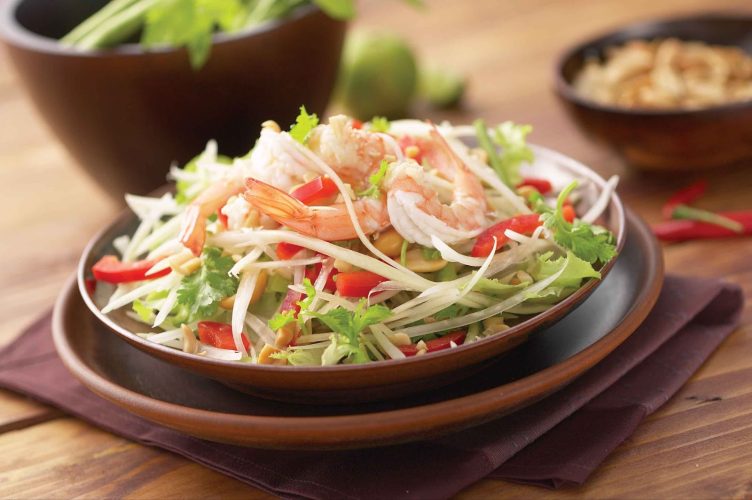
Particularly well-liked as street cuisine is tama hoong, frequently freshly made in front of you by street sellers. A portion of the experience involves witnessing the ingredients being ground into powder in a big mortar and pestle, releasing their fragrant juices and oils. The recipe makes for a filling and well-balanced supper when served with sticky rice and occasionally grilled meats.
3. Khao Niaw (Sticky Rice)
The cornerstone of Lao cuisine is Khao Niaw, or sticky rice, which is usually considered the main portion of many meals. Unlike regular rice, sticky rice obtains its unique chewy texture through soaking and steam cooking.
Consuming it with your hands is customary after receiving it in a little woven basket. A staple of Laotian cuisine, sticky rice is served with nearly all meals and is also used to scoop up a variety of dishes.
Laotian sticky rice is a cultural icon rather than a mere side dish. The “tip khao,” or traditional bamboo baskets, used to serve sticky rice are frequently works of beauty due to their elaborate weaving. The art of making sticky rice has been handed down through many generations; it requires careful soaking and boiling to get the right consistency. As a flexible and valued staple, sticky rice can be enjoyed with savory dishes or a sweet coconut milk dessert.
4. Or Lam (Lao Stew)
Luang Prabang is the birthplace of the flavorful and filling Lao stew known as Or lam. Usually made with slow-cooked beef, poultry, or pig, this dish includes green beans, wood-ear mushrooms, eggplant, and bamboo shoots. Sa Kha, Lao dill, and other regional herbs give Or Lam its distinct flavor. The stew is typically made spicy and soothing by adding chili peppers and thickening it with sticky rice. Sticky rice is generally served with or lam, which perfectly balances the stew’s powerful and deep flavors.
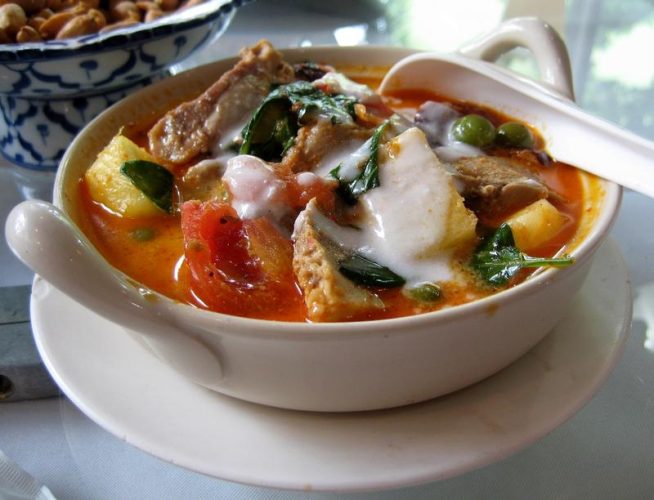
The utilization of exotic components like chile wood, which imparts a distinct peppery flavor, is one of Or Lam’s distinguishing characteristics. Since this item is uncommon outside of Laos, the stew offers a distinctive taste sensation. Or Lam is frequently made for festive occasions and get-togethers with family, which is indicative of its standing as a meal associated with joy and celebration.
5. Sai Oua (Lao Sausage)
Pork is used to make the tasty Lao sausage, or Sai Oua, which is also occasionally blended with rice and other seasonings. This sausage has a unique aromatic flavor that is derived from components such as chile, galangal, lemongrass, and kaffir lime leaves. Fresh veggies and sticky rice are typically served with grilled sue oua. Not only is this sausage a well-liked street snack, but it’s also a typical meal served at parties.
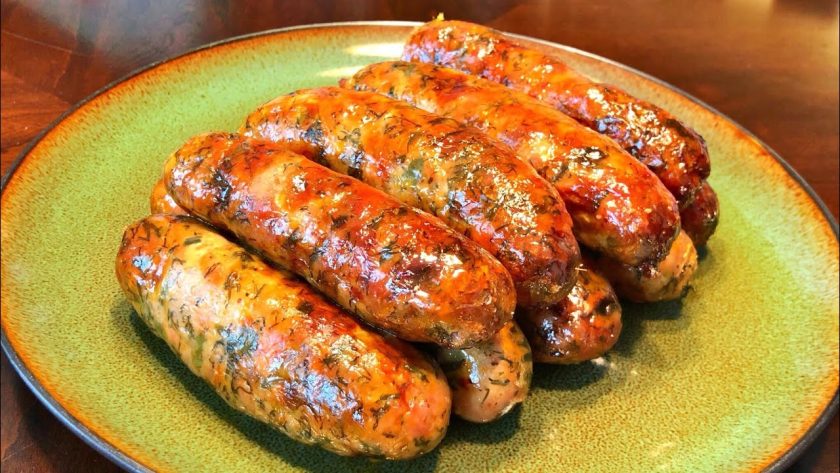
Marinating the beef mixture for a few hours before inserting it into sausage casings is the first step in making Sai Oua. Using this method, the complex flavors of the herbs and spices are guaranteed to be fully expressed in every bite. Sausage gains flavor with grilling, which leaves them with a smoky char. To enhance the taste even further, Sai Oua is frequently consumed with a dipping sauce composed of fermented fish, lime juice, and spice.
6. Mok Pa (Steamed Fish in Banana Leaves)
In Mok Pa, fish is steamed with spices and herbs in banana leaves, creating a delicate and aromatic dish. A marinade of fish sauce, dill, lemongrass, and kaffir lime leaves is applied to the fish, which is typically catfish or tilapia. The mild, earthy aroma of the banana leaves infuses the fish while also keeping it wet. Famous for its delicious yet light taste, mok pa is usually eaten with sticky rice.

To keep the marinade from escaping the fish while it steams, the preparation of mok pa is an art in and of itself, requiring dexterity and ability. The concluding meal is a fish dish that melts in your mouth—tender and fragrant. As a well-rounded and nutrient-dense dinner, mok pa is frequently served with fresh veggies and a hot dipping sauce.
7. Khao Piak Sen (Lao Noodle Soup)
Khao Piak Sen, often known as Lao pho, is a hearty Lao noodle soup. Thick, chewy rice noodles are cooked in a flavorful broth that usually contains pig or poultry. Shallots, garlic, and ginger add seasoning to the broth, making the base-rich and fragrant. A filling and substantial dish suitable for any time of day, Khao Piak Sen is frequently topped with fresh herbs, lime, bean sprouts, and occasionally fried garlic.
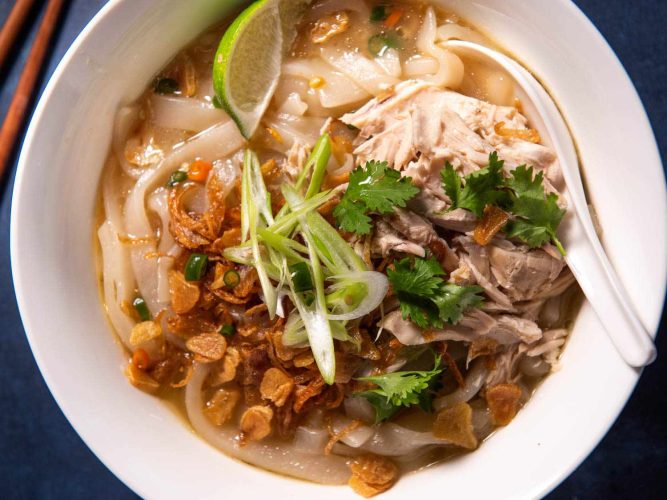
Because the dough is rolled and chopped by hand, Khao Piak Sen noodles have a distinct texture. As a result, they have a somewhat uneven form that enhances the dish’s rustic appeal. Each bowl is personalized with toppings based on the individual’s preferences after the soup is boiled for hours to generate a rich taste. In Laos, Khao Piak Sen is a popular comfort dish that can be eaten for breakfast or dinner.
8. Sien Savanh (Lao Beef Jerky)

Sien Savanh is a type of traditional Lao beef jerky that is marinated in a mixture of fish sauce, sugar, garlic, soy sauce, and black pepper before being mildly smoked or sun-dried. This chewy jerky is well-known for having a savory and slightly sweet flavor, making it an ideal snack.
Sien Savanh is frequently eaten as part of a larger dinner or as a snack with beerlao.
To ensure the flavors seep into the meat, Sien Savanh preparation calls for slicing the beef into thin strips and marinating it for the entire night. This ancient way of drying food has been passed down through the centuries, and depending on the weather, it may take several days.
9. Beerlao
Most Laotians drink Beerlao, and it’s a point of pride for the country. Beerlao, made with imported malt and local rice, is well-balanced and pleasant, with a somewhat sweet flavor. The Lager, Dark, and Gold types are among those available. Beerlao is a national treasure that everybody visiting Laos should eat if they want to sample authentic local cuisine.
Beerlao is one of the most well-known Lao goods worldwide, having received numerous international accolades. Since its founding in 1973, Beerlao has come to represent Lao friendliness. A cold Beerlao is the ideal partner to the vibrant food of the nation, whether you’re dining at a neighborhood restaurant or lounging by the Mekong River.
10. Lao Lao (Lao Rice Whiskey)
Traditionally manufactured in rural areas, Lao Lao is a rice whiskey with a Laotian flavor. Glutinous rice is fermented and then distilled to create a strong, clear liquor that is this formidable alcohol. In festivals and social gatherings, lao lao is usually consumed, and hosts frequently offer guests a shot as a gesture of hospitality. A must-try component of visiting Laos is trying Lao Lao, however, it may be an acquired taste for some.
Each hamlet has its special recipe and method for producing Lao Lao, which differs depending on the locale. Fruits or herbs are often infused into whiskey to provide unique flavors. Lao Lao is thought to have several health advantages and is also utilized in traditional Lao medicine. More than just a social pastime, drinking Lao Lao helps you become immersed in the customs and culture of the area.
Lang Biang Mountain: An Adventure Awaits in Da Lat, Vietnam
Hua Hin Adventure: Top Spots and Insider Tips for Your Visit






